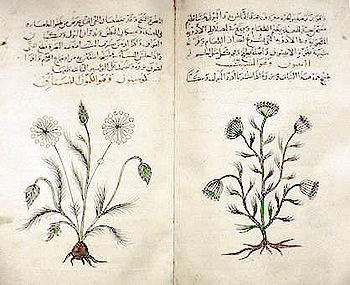Drying of herbs and spices
 Wednesday, June 9, 2010
Wednesday, June 9, 2010See also: Drying of herbs and spices
The exact composition of a herbal product is influenced by the method of extraction. A tisane will be rich in polar components because water is a polar solvent. Oil on the other hand is a non-polar solvent and it will absorb non-polar compounds. Alcohol lies somewhere in between. There are many forms in which herbs can be administered, these include:
- Tinctures - Alcoholic extracts of herbs such as Echinacea extract. Usually obtained by combining 100% pure ethanol (or a mixture of 100% ethanol with water) with the herb. A completed tincture has a ethanol percentage of at least 25% (sometimes up to 90%).[67]. The term tincture is sometimes applied to preparations using other solvents than ethanol.
- Herbal wine and elixirs - These are alcoholic extract of herbs; usually with an ethanol percentage of 12-38% [67] Herbal wine is a maceration of herbs in wine, while an elixir is a maceration of herbs in spirits (e.g., vodka, grappa, etc.)
- Tisanes - Hot water extracts of herb, such as chamomile.
- Decoctions - Long-term boiled extract of usually roots or bark.
- Macerates - Cold infusion of plants with high mucilage-content as sage, thyme, etc. Plants are chopped and added to cold water. They are then left to stand for 7 to 12 hours (depending on herb used). For most macerates 10 hours is used.[67]
- Vinegars - Prepared at the same way as tinctures, except using a solution of acetic acid as the solvent.
- Topicals:
- Essential oils - Application of essential oil extracts, usually diluted in a carrier oil (many essential oils can burn the skin or are simply too high dose used straight – diluting in olive oil or another food grade oil such as almond oil can allow these to be used safely as a topical).[68]
- Salves, oils, balms, creams and lotions - Most topical applications are oil extractions of herbs. Taking a food grade oil and soaking herbs in it for anywhere from weeks to months allows certain phytochemicals to be extracted into the oil. This oil can then be made into salves, creams, lotions, or simply used as an oil for topical application. Any massage oils, antibacterial salves and wound healing compounds are made this way.
- Poultices and compresses - One can also make a poultice or compress using whole herb (or the appropriate part of the plant) usually crushed or dried and re-hydrated with a small amount of water and then applied directly in a bandage, cloth or just as is.
- Whole herb consumption - This can occur in either dried form (herbal powder), or freshjuice, (fresh leaves and other plant parts).
- Syrups - Extracts of herbs made with syrup or honey. Sixty five parts of sugar are mixed with 35 parts of water and herb. The whole is then boiled and macerated for three weeks.[67]
- Extracts - Include liquid extracts, dry extracts and nebulisates. Liquid extracts are liquids with a lower ethanol percentage than tinctures. They can (and are usually) made by vacuum distilling tinctures. Dry extracts are extracts of plant material which are evaporated into a dry mass. They can then be further refined to a capsule or tablet.[67] A nebulisate is a dry extract created by freeze-drying.
- Inhalation as in aromatherapy can be used as a mood changing treatment[69][70] to fight a sinus infection or cough [71][citation needed], or to cleanse the skin on a deeper level (steam rather than direct inhalation here)[citation needed]
- Apply fresh herb paste on skin.
- Ground herb and boil in water such as herbal tea.
 Filed Under :
Filed Under :





No comments:
Post a Comment